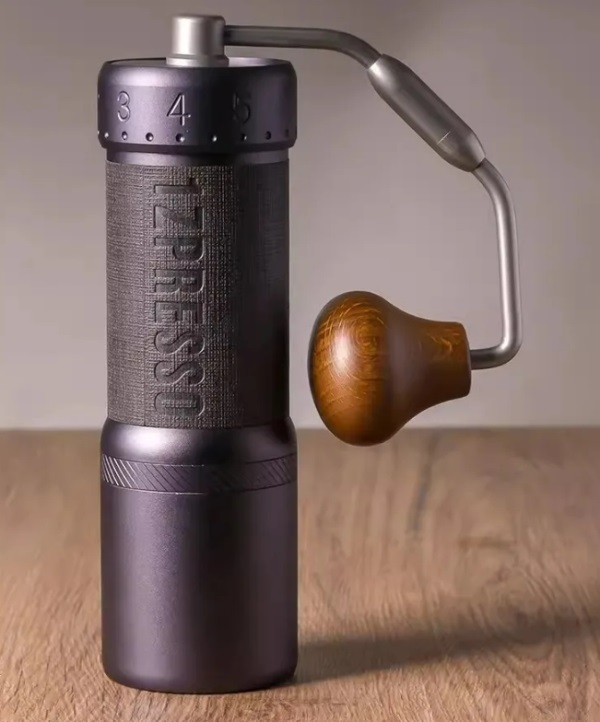Grind with Self-confidence: Experience the 1Zpresso J-Max Coffee Mill
Wiki Article
Master the Art of Grinding Coffee Beans: A Guide to Coffee Grinders
For coffee enthusiasts, the process of grinding coffee beans is even more than simply a regular job; it is an art form that can substantially influence the flavor and top quality of the last brew. Understanding the nuances of various mill kinds, selecting the ideal work dimension, and using the right strategies are vital steps in the direction of achieving that excellent cup of coffee.Kinds Of Coffee Grinders
There are 3 main kinds of coffee grinders commonly used by coffee lovers: blade mills, burr grinders, and hands-on grinders. Blade grinders are the most basic type, utilizing a straightforward blade to slice the coffee beans. While they are economical and easy to utilize, they frequently result in irregular coffee grounds due to inconsistent grinding.Manual mills, as the name suggests, need hand-operated initiative to grind the coffee beans. They are typically liked by those that delight in the process of hand developing coffee or for those who value portability. Manual mills can differ in style, from basic portable versions to a lot more detailed countertop versions. While they might require even more effort, manual mills supply control over the grinding process, permitting users to readjust the work size to their choice. Each kind of coffee mill has its advantages and optimal usage situations, providing to the diverse preferences of coffee fanatics.

Selecting the Right Grind Size
With an understanding of the different types of coffee grinders, the following critical step in attaining the ideal cup of coffee is selecting the best work dimension. The work size plays a considerable duty in establishing the flavor account of your coffee (1Zpresso J-Ultra). Different developing techniques require specific grind dimensions to maximize the extraction of flavors from the coffee groundsFor a coarse grind, ideal for French press and cold mixture methods, the coffee beans need to look like breadcrumbs, supplying a durable and vibrant flavor. Medium-coarse grinds, ideal for Chemex or Clever Dripper, have an appearance comparable to coarse sand, supplying a well balanced preference.
Medium grinds, frequently utilized in drip coffee manufacturers, have a consistency appearing like routine sand, leading to an all-round flavor. Great grinds, best for coffee devices, are comparable to common salt, producing a rich and intense preference. Lastly, extra-fine grinds, used in Turkish coffee, are as great as powdered sugar and create a strong and potent brew.
Grinding Techniques for Ideal Flavor
To remove the maximum capacity of taste from your coffee beans, grasping appropriate grinding techniques is necessary. Consistency is crucial when it comes to grinding coffee beans for optimal flavor. By paying interest to these grinding strategies, you can boost the taste profile of your coffee and appreciate a more gratifying mug every time.Maintenance and Cleansing Tips

In addition to regular cleansing, it is vital to examine your grinder for any kind of signs of wear or damage. Check the blades, burrs, and other parts for any dullness or breakdowns. Replace any type of damaged components promptly to maintain the high quality of your coffee work. Finally, store your mill in a dry and tidy setting to avoid any type of dampness or dirt from affecting its efficiency. By complying with these maintenance and cleansing suggestions, you can make sure that your coffee grinder continues to provide tasty fresh ground coffee for several years to come.
Troubleshooting Common Mill Issues


Guaranteeing your coffee grinder operates smoothly requires skilled troubleshooting of common concerns that might occur during its usage. One usual issue with coffee grinders is irregular work dimension. This problem can take place because of dull blades, incorrect calibration, or irregular coffee beans. To address this, ensure your mill's blades are sharp and properly lined up, adjust the mill according to the wanted grind size, and shake the grinder delicately while being used to aid achieve a much more uniform work.
This can take place when oils from the coffee beans build up and obstruct the grinder's chute. To resolve this, take apart the grinder and tidy all components thoroughly, paying special focus to the chute and burrs.
Last but not least, if your mill is generating too much sound during procedure, it could indicate a trouble with the electric motor or interior elements. In such instances, it is a good idea to consult the supplier's directions for troubleshooting steps or look for expert help to diagnose and correct the concern promptly.
Final Thought
To conclude, understanding the art of grinding coffee beans includes recognizing the different kinds of coffee mills, choosing the right grind size, making use of appropriate grinding techniques for optimal taste, and keeping and cleaning the mill consistently. By complying with these standards and fixing usual mill problems, coffee fanatics can elevate their coffee developing experience and enjoy a scrumptious cup of coffee each time.Report this wiki page